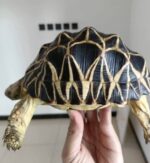Description
The Burmese star tortoise for sale (Geochelone platynota) is a critically endangered tortoise species, native to the dry, deciduous forests of Myanmar (Burma).
Description of Burmese Star Tortoise For Sale
The Burmese star tortoise has radiating star-shaped patterns on its strongly domed carapace. It has bumps on its shell that look like stars. This tortoise can easily be distinguished from the more common Indian star tortoise by comparing the plastrons of the two species.
Captive breeding
The breeding of the Burmese star tortoise is difficult, and its first successful breeding in captivity was in Taipei Zoo, Taiwan, where a few Burmese star tortoises were hatched in 2003.
Yadanabon Zoological Gardens is also currently engaged in a captive-breeding program to attempt to increase the population of this tortoise.
Starting with 200 tortoises in 2004, by October 2017, there were 14,000 tortoises in breeding programs and 1000 have been reintroduced into the wild. On 31 July 2021, Richard Branson announced two baby Burmese star tortoises were born on his private island, Necker Island, as part of his ongoing conservation work for the species.
Anatomy and morphology
The carapace of G. elegans is very convex, with dorsal shields often forming humps; the lateral margins are nearly vertical; the posterior margin is somewhat expanded and strongly serrated. It has no nuchal scute, and the supracaudal is undivided, and curved inward in the male; the shields are strongly striated concentrically. The first vertebral scute is longer than broad, and the others are broader than long, with the third at least as broad as the corresponding costal.
Distribution and habitat of Burmese Star Tortoise For Sale

Indian star tortoises are native to parts of western and southeastern India, the island of Sri Lanka, and southeastern Pakistan. Although there are no recognized subspecies, there are variations in color and morphology between the tortoises found in the different regions.
The Burmese Star Tortoise For Sale found in southeastern India tend to be a bit smaller and have a lighter, more contrasting pattern on their shell compared to the ones found in northern India. The tortoises in Sri Lanka tend to have wider yellow markings and are generally larger than the tortoises found in India. Little used to be known about the phylogeographic differentiation in the Indian star tortoises until a study done by Gaur in 2006.
The study revealed that the tortoises from the distribution patches between India and Sri Lanka are indeed distinct. These tortoises are known to widely inhabit many different types of habitats across India, Sri Lanka, and Pakistan. They have displayed a very high tolerance to areas with seasonally dry and wet habitats. Star tortoises have been found in rainy deciduous forests, dry grasslands, and even semi-desert lands.[



















Reviews
There are no reviews yet.